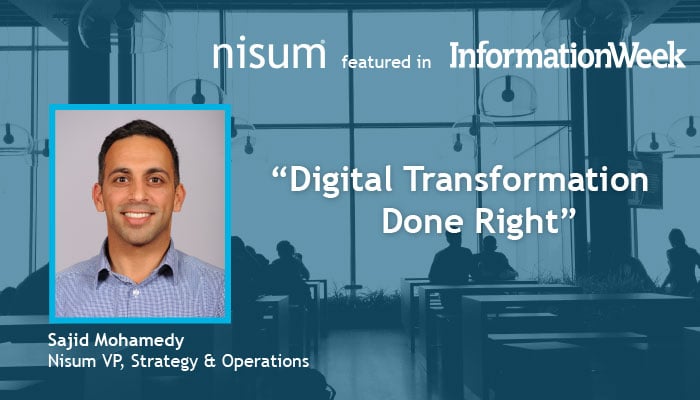Nisum VP, Sajid Mohamedy talks about the importance of a comprehensive digital strategy that involves an organization’s entire business model in his InformationWeek article titled “Digital Transformation Done Right.” Read the full text below or see the article on InformationWeek here.

Digital Transformation Done Right
A successful digital transformation initiative starts with an organization's leadership instilling a culture that supports the idea of the entire business operating under one digital strategy.
Digital transformation is the topic on the minds of CIOs. Every organization seems to have some sort of big data initiative, but that doesn’t mean the vision is being implemented and executed upon effectively. In fact, the latest data tells us that it’s not; only 4% of companies are able to combine the right people, tools, data and organizational focus to take advantage of big data and analytics. This means that the vast majority of organizations are making massive investments on the latest or hottest tech solutions, without a significant return. Digital transformation done right is not about chasing the newest shiny object, rather, it begins with a sound strategy in place before a single dollar is invested in tech. The initiative also relies on the key elements of culture and leadership within the organization.
Strategy
To make the most of digital transformation initiatives, it’s critical to have a sound strategy in place, and the real advantage for organizations will come from approaching strategy differently than your competitors. Yes, this means not simply investing in a new technology for the sake of having the latest and greatest, but much deal more. Having the proper foundation in place to support digital transformation involves reviewing the entire business model and adjusting accordingly, and then allowing that strategy to be a guiding light for the entire business. We know that the paradigm for the buyer/seller relationship has flipped; today, customers have more options and control in their purchasing decisions than ever before. People can compare the same product or service across different sales channels, by price, and with the help of reviews and recommendations from previous customers and their social connections. As such, the idea of the empowered customer should be at the heart of any digital transformation strategy. Organizations that refuse to acknowledge this simply will not survive. Instead, sellers must meet their customers where they are and in ways that are interesting to them.
Culture
All too often we see companies “talk the talk” about implementing new technologies, but from a cultural perspective they continue to operate as if it were 20 years ago. When it comes to adopting digital transformation and their business, the two are viewed as separate entities rather than part and parcel of one another. If an organization is serious about digital transformation, every employee is on the hook for making sure this happens. This means a cultural attitude shift that embraces leaner, fail-fast projects, and interacting with customers faster than ever before. Culture, however, doesn’t happen by accident. Organizations must be deliberate in implementing a culture that fosters digital transformation. As an example, think of the in-store experience when you walk into an Apple store compared to walking into Sears. Change certainly can be scary, but a lean, startup attitude across the entire organization is key to digital transformation.
Leadership
Many companies will carve out roles for leaders to specifically focus on innovation and digital transformation, but this is not the best approach. Leadership around digital transformation has to start with the CEO, and the CEO must be willing to invest in breaking down the old ways of doing business, and understand the value of trying something new, embracing innovative ways of interacting with customers. As a cautionary tale, we can look at what happened earlier this year with United Airlines. Leadership at the company was still trying to operate under the old model, thinking they could control the narrative after a passenger was forcibly removed from a plane due to overbooking. United clearly underestimated the role of digital and social in brand reputation in today’s market; whereas as a disruptive player like Virgin Airlines embraces digital as a way to enhance and facilitate the customer experience. Digital transformation is a must for today’s organizations; if you’re not willing to change business as usual, your competition will. However, the existing approach to digital has to change. Chief Innovation Officers, Chief Omnichannel Officers, and all of the other new titles popping up in the C-suite, indicate that organizations are realizing that they need to embrace digital, but they also imply that organizations think need a bridge-builder to connect all of their different channels, effectively maintaining organizational silos. Leadership must instill a culture that supports the idea of the entire business operating under one digital strategy. Only with this mindset and approach in place does digital have the power to truly transform an organization.



